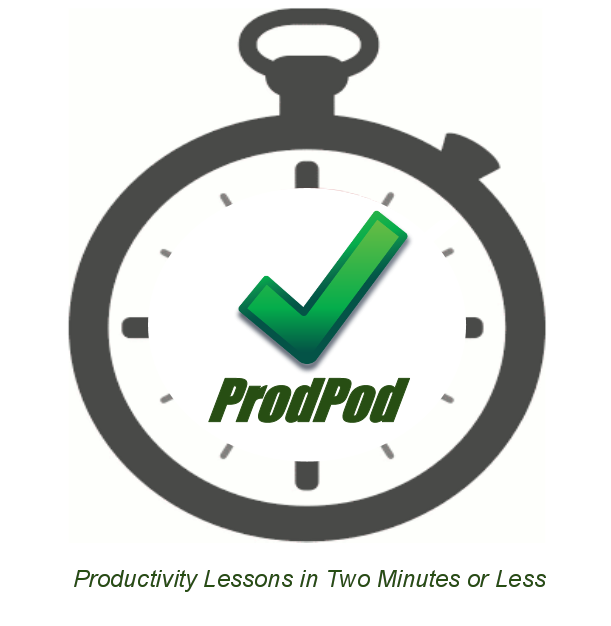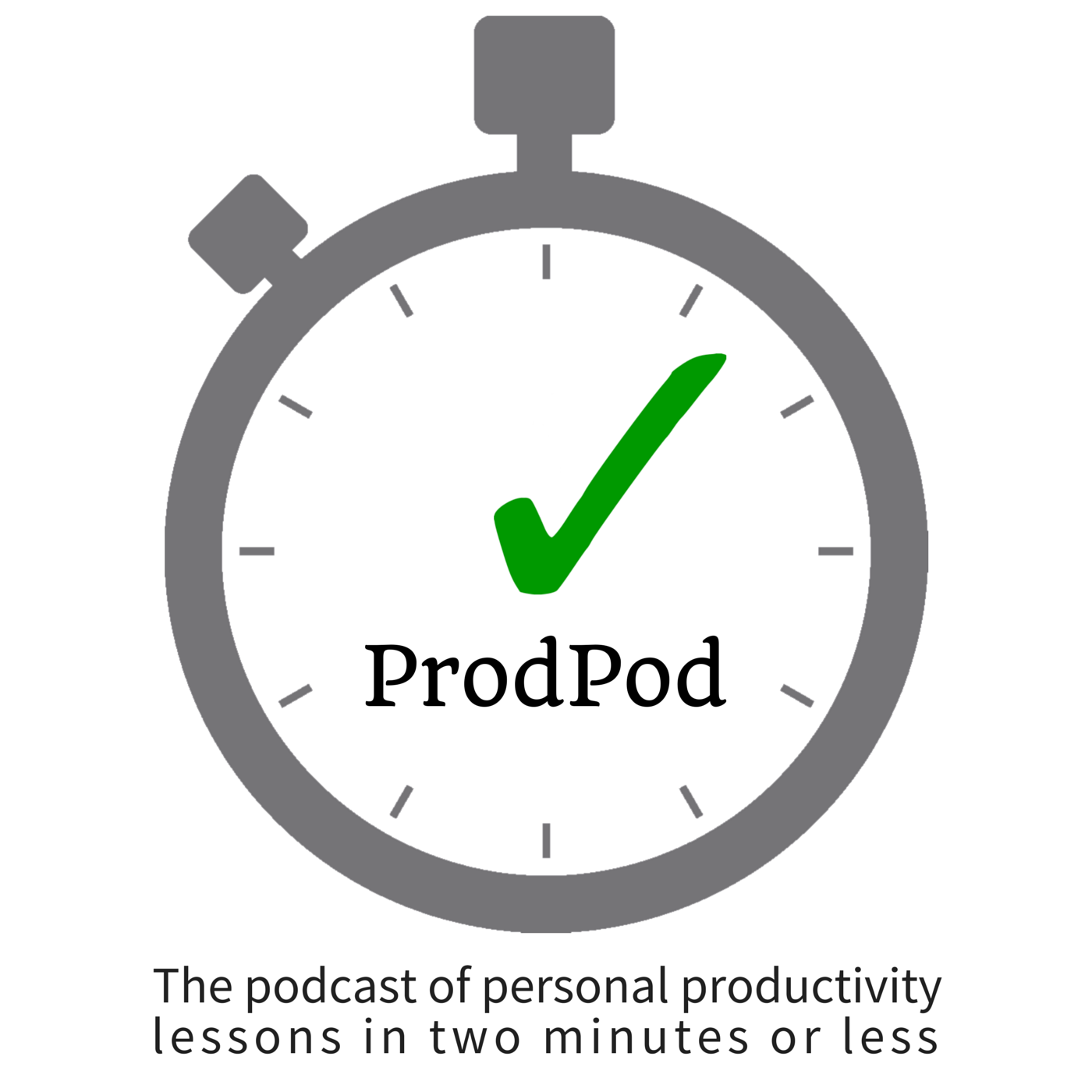Episodes

Thursday Aug 11, 2011
ProdPod: Episode 11 -- Power Productivity Through Active Listening
Thursday Aug 11, 2011
Thursday Aug 11, 2011
This episode is a series of quick tips I've gathered over time for power productivity through active listening.
We have so many forms of communication available to us today. Technology keeps improving and with a globally-connected, 24/7 society, you could easily have engaging conversations 'round the clock. With all this capacity and experience with digital communication technologies, it makes sense that some of our interpersonal skills will change or need refreshing, like active listening. This episode is a series of quick tips I've gathered over time for power productivity through active listening.
1. Ask more questions than giving declarative statements, then stop talking and listen to the answers being given. You'll be surprised how much you can accomplish when you let others do and say more.
3. Ask clarifying questions to let your speaker know you're listening and engaged.
4. When possible, make eye contact and pay attention to body language.
5. Repeat back what is said in your own words, so the speaker knows you listened and understood what was said. This is also an opportunity for her to clarify in case you haven't.
6. Once you have mastered the art of active listening. Teach it to others. Pay it forward. As the old adage goes, if you teach something you learn it twice, plus it will save you time and hassle in the future.
2. Hearing is a sense. Listening is an active process. Develop your skills for listening not just hearing.

Tuesday Aug 09, 2011
ProdPod: Episode Ten -- Meta-Tasking
Tuesday Aug 09, 2011
Tuesday Aug 09, 2011
In the last episode, I explained the benefits of single-tasking, or completing one task at a time, over multi-tasking. Well, in this episode's tip: I'd like to introduce a new kind of productivity technique I've coined "meta-tasking."
What if we can take the benefits of single-tasking--focus, greater creativity, more time to relax and less stress, and faster completion of tasks, and add the mythical promise of getting more done by multi-tasking?
First, break your day into locations and activities. For example, Home, Commute, Office, Gym, Commute, Home, and Bed are my basic times within which I control my work. Next, ask yourself what tasks daily, weekly, monthly, or any other repeating schedule, do I have to do things like meal preparation, laundry, cleaning, calling customer service or tech support with extended wait times, grocery shopping, etc. For each repeating errand, I can calculate conservatively from experience how much time they take. Finally, I look at my next-actions or projects list and find items that can be grouped together and done during these times when much of my activity requires waiting, for example, while the laundry and dryer are going, I can accomplish two to four 15-minute tasks.
When I'm planning my week ahead, I just review my calendar for these repeating errands and I can quickly and easily fill that time in with more productive tasks.
Remember, in order for meta-tasking to truly be beneficial is to prioritize tasks where shifting focus is minimal and gives you ample time to finish. Set yourself up for success by having small tasks grouped together. Satisfaction is the goal here, not just efficiency.

Thursday Aug 04, 2011
ProdPod: Episode Nine -- Single-Tasking
Thursday Aug 04, 2011
Thursday Aug 04, 2011
This episode's tip: Single-tasking is the way to achieve more with greater focus and less stress, not multi-tasking.
So, what are you doing when you're multi-tasking? You're actually quickly changing focus back and forth between each task. And just like a car, you cannot turn the vehicle in two directions concurrently. And every time you turn the vehicle, you must slow down, recalibrate the car's direction then return acceleration to your original cruising speed. This takes careful focus and time not only with a car but with a change in each task.
In essence "single-tasking" to complete a task fully as the only item you're focusing and/or working on is more efficient than the notion of multi-tasking. The ancillary benefits are focus, less stress and faster project completion. This all equates to more time to relax or accomplish more goals that are fulfilling to your productive life.

Tuesday Aug 02, 2011
ProdPod: Episode Eight -- Leaving Presentations Ready for Action
Tuesday Aug 02, 2011
Tuesday Aug 02, 2011
This episode's tip: How to leave a presentation ready for action with handouts.
Productivity and presentations can almost be considered antonyms to the common seminar or workshop attendee. Everyone's time is limited and they usually don't take the information gained into action. I've heard statistics that over two-thirds of individuals use *none* of the actionable information from professional conferences. One of the main reasons, I believe, most people accomplish so little when they leave educational events is that they do not design their experience for the outcome that's most advantageous to them. This episode's tip: How to leave a presentation ready for action with handouts.
Initially, I assess the information and giveaways I receive from tradeshow exhibitors or sponsors. Are really worth keeping? They become distractions once you're seated if you don't properly commit to putting them out of sight once the speaker begins. While I'm at it, I usually try to get a seat early on to make sure I have a clear view of the presenter, I am within audible range in case the speaker doesn't have suitable amplification, and I confirm any visual aids I've identified are in sight.
So, with no external distractions that are within my control, I pull out the materials and give it a general context and content overview. I quickly underline or star the margins in areas where I'll want to make sure I pay special attention. On a separate sheet of notepaper, I use my flavor of Note-Taking explained in Episode Seven. As soon as the presentation is over, I make sure to follow GTD practice to process what I captured and then organize it into its proper list/tool (calendar, reference file, project, next-action, someday-maybe and so forth). Because I managed the information well both before and during, I can now engage in networking and getting refreshments with ease of mind. When I get back to my office, I'm very likely to take my hard work to the next level and it's all ready for me...ready for action.

Thursday Jul 21, 2011
Thursday Jul 21, 2011
THIS EPISODE'S TIP IN OUR SERIES ON EFFECTIVE MEETINGS: CORNELL NOTE-TAKING METHOD FOR MEETINGS. CREATED BY WALTER PAUK, EMERITUS, AT CORNELL UNIVERSITY THIS METHODOLOGY WAS CREATED TO HELP STUDENTS TAKE NOTES AND LEARN FROM THEM THROUGHOUT A COLLEGE COURSE. I'VE MODIFIED THE CONCEPTS SLIGHTLY TO SUIT MY PROFESSIONAL NEEDS.
THIS EPISODE'S TIP IN OUR SERIES ON EFFECTIVE MEETINGS: CORNELL NOTE-TAKING METHOD FOR MEETINGS. CREATED BY WALTER PAUK, EMERITUS, AT CORNELL UNIVERSITY THIS METHODOLOGY WAS CREATED TO HELP STUDENTS TAKE NOTES AND LEARN FROM THEM THROUGHOUT A COLLEGE COURSE. I'VE MODIFIED THE CONCEPTS SLIGHTLY TO SUIT MY PROFESSIONAL NEEDS. IF YOU GOOGLE "CORNELL NOTE TAKING TEMPLATE" YOU'LL FIND A VISUAL AS I DESCRIBE THE LAYOUT.
IN SHORT, YOU HAVE THREE AREAS DESIGNATED ON A SHEET OF NOTEPAD PAPER WHICH ALONG THE LEFT-HAND SIDE COLUMN IS THE CUE C-U-E COLUMN, TO THE RIGHT OF THAT IS THE NOTE-TAKING AREA AND THE BOTTOM TWO INCHES ARE DEDICATED AS A SUMMARY AREA. I PUT THE MEETING AGENDA NEXT TO MY NOTEPAD SO I CAN FOLLOW ALONG WHILE I TAKE NOTES.
AS YOU ATTEND THE MEETING, TAKE SUBSTANTIVE NOTES IN CHRONOLOGICAL ORDER AS THEY ARE DISCUSSED IN THE MEETING AGENDA IN THE NOTE-TAKING AREA. AS THE MEETING ADJOURNS, THIS IS YOUR TIME TO REFLECT ON THE MEETING BY REVIEWING YOUR NOTES AND USE THE CUE COLUMN, AKA RECALL COLUMN, TO CREATE TWO TO FOUR WORD QUESTIONS (FOR EXAMPLE, HOW TO DESIGN BROCHURE?) AS A REFERENCE REMINDER FOR THE CONTEXT OF EACH OF THE NOTES IN THE NOTE-TAKING AREA. RIGHT AFTER YOU'VE CUED YOUR NOTES, IN THE SUMMARY AREA, SUMMARIZE THE OUTCOME OF THE MEETING IN TWO TO THREE SUCCINCT SENTENCES AS WELL AS NEXT-ACTIONS. COME YOUR GTD WEEKLY REVIEW, OR WHENEVER YOU REVIEW YOUR WEEK PAST AND WEEK AHEAD, YOU HAVE YOUR NOTES IN A FORMAT THAT WILL HELP YOU QUESTION AND ANSWER YOUR WAY THROUGH THE MEETING FOR OPTIMUM RECALL AND RETENTION.
FOLLOWING CORNELL NOTE-TAKING METHODOLOGY FOR MEETINGS AS I'VE DESCRIBED, YOU'LL KNOW THE PURPOSE OF EVERY MEETING, WHAT WAS HANDLED IN THEM AND WHAT THE OUTCOMES WERE AT A GLANCE WHENEVER YOU NEED TO REFER BACK TO IT.
I HOPE YOU ENJOYED THIS EPISODE OF PRODPOD. THIS IS RAY SIDNEY-SMITH AND THANKS FOR LISTENING! HERE'S TO YOUR PRODUCTIVITY SUCCESS...IN TWO MINUTES OR LESS.

